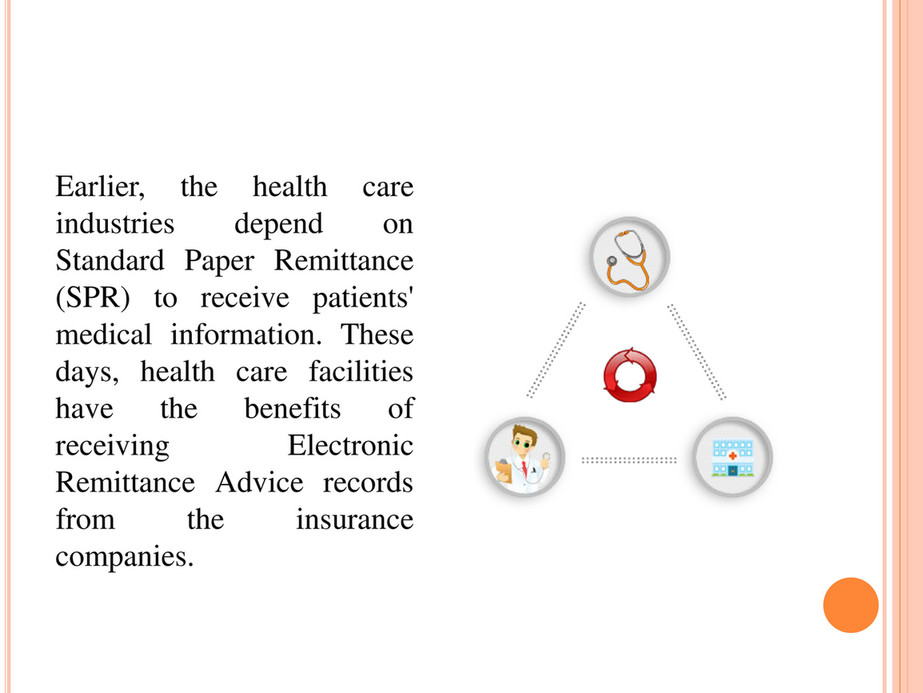
Navigating the complex world of healthcare billing and payments can feel like traversing a labyrinth. Paper-based processes, manual data entry, and the endless stream of physical documents can quickly become overwhelming. Healthcare providers are constantly seeking ways to streamline these administrative tasks, reduce errors, and improve efficiency. Embracing electronic solutions is the key to unlocking a smoother, more manageable workflow.
The transition to electronic systems is not merely about adopting new technologies; it’s about fundamentally changing the way healthcare businesses operate. It’s about embracing innovation, optimizing workflows, and ultimately, providing better patient care by freeing up valuable time and resources. The benefits extend far beyond simply reducing paper clutter.
By automating processes like claims submissions and payment reconciliation, healthcare providers can significantly reduce the risk of human error. This leads to fewer rejected claims, faster payments, and a more predictable revenue cycle. This translates into improved cash flow and greater financial stability.
Furthermore, electronic systems offer enhanced security and compliance. Data is protected through encryption and access controls, ensuring that sensitive patient information remains confidential and secure. This is particularly crucial in today’s environment, where data breaches are a constant threat.
Therefore, we must consider different enrollment options such as **HealthPartners Electronic Remittance Advice Enrollment**. This will enable an understanding of the important role they play in today’s health care system.
Understanding Electronic Remittance Advice (ERA)
What is an ERA?
An Electronic Remittance Advice (ERA), also known as an 835 transaction, is an electronic version of a paper explanation of benefits (EOB). It contains detailed information about claim payments, adjustments, and denials, all delivered electronically rather than through the mail.
Instead of manually entering data from paper EOBs, providers can automatically post payments and adjustments to patient accounts using ERAs. This eliminates the need for manual keying, which significantly reduces errors and speeds up the reconciliation process.
ERAs provide a standardized format for receiving payment information from payers, making it easier for providers to manage their finances and track claims. This standardized format also facilitates data analysis and reporting, providing valuable insights into payer performance and revenue cycle trends.
The adoption of ERAs is a crucial step towards achieving a fully electronic healthcare system, reducing administrative burdens and improving overall efficiency. The benefits of using ERAs are numerous, contributing to a more streamlined and cost-effective revenue cycle.
The convenience and accuracy of ERAs make them an essential tool for any healthcare provider looking to optimize their financial operations and improve their bottom line.
Benefits of Using ERAs
The advantages of switching to ERAs are undeniable. One of the most significant benefits is the reduction in manual data entry, which saves time and minimizes the risk of errors. This allows staff to focus on more critical tasks, such as patient care and revenue cycle management.
Faster payment posting is another key advantage. ERAs allow for automated payment reconciliation, which significantly reduces the time it takes to post payments to patient accounts. This leads to improved cash flow and a more predictable revenue cycle.
Reduced paper consumption is also a significant benefit. By eliminating the need for paper EOBs, providers can reduce their environmental impact and save on printing and mailing costs. This contributes to a more sustainable and cost-effective business operation.
Improved accuracy is another major advantage. ERAs provide a standardized format for payment information, which reduces the risk of errors associated with manual data entry. This leads to fewer rejected claims and faster payments.
Enhanced security is also a key benefit. ERAs are transmitted electronically using secure protocols, which protects sensitive patient information from unauthorized access. This is particularly important in today’s environment, where data breaches are a constant threat.
Challenges of Transitioning to ERAs
Despite the numerous benefits, transitioning to ERAs can present some challenges. One of the biggest hurdles is the initial setup and configuration. This may require technical expertise and coordination with payers and clearinghouses.
Another challenge is ensuring that your practice management system is compatible with ERA technology. This may require upgrading your software or implementing new integrations.
Staff training is also crucial. It’s important to provide adequate training to staff on how to use ERA technology and how to reconcile payments electronically. This will ensure that the transition is smooth and that the benefits of ERAs are fully realized.
Addressing payer enrollment requirements can also be a challenge. Each payer may have different enrollment processes and requirements, which can be time-consuming and complex.
Overcoming these challenges requires careful planning, effective communication, and a commitment to embracing new technology. However, the long-term benefits of ERAs far outweigh the initial challenges.
HealthPartners Electronic Remittance Advice Enrollment: A Step-by-Step Guide
Understanding the HealthPartners Enrollment Process
Enrolling in **HealthPartners Electronic Remittance Advice Enrollment** requires careful attention to detail. The process typically involves completing an enrollment form, providing necessary documentation, and working with a clearinghouse to establish a secure connection.
The first step is to obtain the correct enrollment form from HealthPartners. This form will require you to provide information about your practice, including your tax ID, NPI number, and contact information.
Next, you will need to select a clearinghouse that supports HealthPartners ERA transactions. The clearinghouse will act as an intermediary between your practice and HealthPartners, ensuring that the data is transmitted securely and accurately.
You will also need to ensure that your practice management system is configured to receive ERAs from the clearinghouse. This may require working with your software vendor to configure the necessary settings.
Once you have completed the enrollment form and configured your system, you will need to submit the enrollment form to HealthPartners. The enrollment process can take several weeks, so it’s important to be patient and follow up with HealthPartners if you haven’t received confirmation within a reasonable timeframe.
Required Documentation for Enrollment
The documentation required for **HealthPartners Electronic Remittance Advice Enrollment** typically includes your practice’s tax ID, NPI number, and a copy of your clearinghouse agreement. You may also need to provide proof of authorization to receive electronic payments on behalf of your practice.
Ensuring that you have all the necessary documentation before starting the enrollment process can help to avoid delays and ensure a smooth transition.
Double-check all information for accuracy, as errors can cause significant delays in the enrollment process. It’s always better to be thorough and double-check everything.
Keep copies of all documents submitted to HealthPartners for your records. This will be helpful if you need to refer to them later on.
Pay close attention to any specific instructions provided by HealthPartners regarding the documentation requirements. Following these instructions carefully will help to ensure that your enrollment is processed quickly and efficiently.
Working with a Clearinghouse
A clearinghouse plays a critical role in the ERA enrollment process. It acts as a middleman between your practice and HealthPartners, ensuring that data is transmitted securely and accurately.
When selecting a clearinghouse, it’s important to choose one that is reputable and experienced in handling ERA transactions with HealthPartners.
The clearinghouse will work with you to configure your practice management system to receive ERAs and will provide support throughout the enrollment process.
They will also monitor the transmission of data to ensure that it is delivered securely and accurately.
A good clearinghouse will also provide you with reporting tools and analytics that can help you to track your claim payments and identify any potential issues.
Troubleshooting Common Enrollment Issues
Incorrect Information on Enrollment Forms
One of the most common issues encountered during **HealthPartners Electronic Remittance Advice Enrollment** is providing incorrect information on the enrollment forms. This can lead to delays and even rejection of the enrollment application.
To avoid this issue, carefully review all information before submitting the enrollment form. Double-check the accuracy of your tax ID, NPI number, and contact information.
If you do discover an error, correct it immediately and resubmit the enrollment form. Don’t wait until you receive a rejection notice to correct the error.
It’s also a good idea to keep a copy of the completed enrollment form for your records so that you can easily refer back to it if needed.
By taking the time to review and verify the accuracy of your information, you can significantly reduce the risk of delays and ensure a smooth enrollment process.
Clearinghouse Connectivity Problems
Connectivity issues between your practice management system and the clearinghouse can also cause problems during ERA enrollment.
To troubleshoot these issues, first verify that your internet connection is working properly. Then, check the configuration settings in your practice management system to ensure that they are correct.
Contact your clearinghouse for assistance if you are unable to resolve the connectivity issues on your own. They can provide technical support and help you to configure your system properly.
It’s also important to keep your software up to date to ensure that it is compatible with the latest clearinghouse protocols.
Regularly test your connection to the clearinghouse to ensure that it is working properly. This will help you to identify and resolve any issues before they cause problems with your ERA enrollment.
Payer Rejection of Enrollment
In some cases, HealthPartners may reject your ERA enrollment application. This can be due to a variety of reasons, such as missing documentation or incorrect information.
If your enrollment application is rejected, carefully review the rejection notice to determine the reason for the rejection.
Correct any errors or omissions and resubmit the enrollment application. Be sure to include any additional documentation that is requested.
Contact HealthPartners directly if you have any questions about the rejection notice or the enrollment process.
Persistence is key. Don’t give up if your enrollment application is rejected. By carefully addressing the issues and resubmitting your application, you can eventually get approved for ERA enrollment.
Optimizing Your ERA Workflow Post-Enrollment
Automating Payment Posting
Once you are enrolled in ERAs, the next step is to optimize your workflow by automating payment posting. This will save you significant time and reduce the risk of errors.
Configure your practice management system to automatically import ERAs from your clearinghouse. This will eliminate the need for manual data entry.
Set up rules to automatically match payments to patient accounts based on claim numbers, dates of service, and other criteria.
Regularly review and refine your payment posting rules to ensure that they are working accurately and efficiently.
Monitor your automated payment posting process closely to identify and resolve any potential issues.
Reconciling ERAs with Bank Deposits
Reconciling ERAs with your bank deposits is essential for ensuring that all payments are accounted for and that there are no discrepancies.
Compare the total amount of payments listed on your ERAs with the amount deposited into your bank account.
Investigate any discrepancies and determine the cause. This may involve contacting HealthPartners or your clearinghouse for clarification.
Keep accurate records of all ERA transactions and bank deposits. This will make it easier to reconcile your accounts and identify any potential issues.
Regularly reconcile your ERAs with your bank deposits to ensure that your financial records are accurate and up to date.
Analyzing ERA Data for Insights
ERAs contain a wealth of information that can be used to gain insights into your practice’s financial performance.
Analyze your ERA data to identify trends in claim payments, denials, and adjustments.
Use this information to identify areas where you can improve your billing practices and reduce the number of rejected claims.
Track your payer performance over time to identify which payers are paying promptly and accurately.
Use ERA data to negotiate better payment rates with payers and improve your overall financial performance.
The Future of Electronic Remittance Advice
Increased Adoption of Automation
The future of ERAs is likely to involve increased adoption of automation. As technology advances, more and more healthcare providers will be able to automate their payment posting and reconciliation processes.
This will lead to significant time savings and reduced errors, allowing healthcare providers to focus on providing better patient care.
Cloud-based solutions and artificial intelligence will play an increasingly important role in automating ERA workflows.
The standardization of ERA formats and data exchange protocols will also facilitate increased automation.
Healthcare providers who embrace automation will be better positioned to thrive in the ever-changing healthcare landscape.
Integration with Other Healthcare Technologies
ERAs are also likely to become more integrated with other healthcare technologies, such as electronic health records (EHRs) and practice management systems.
This integration will allow for seamless data exchange and improved workflow efficiency.
For example, ERA data could be automatically populated into patient charts, providing clinicians with a more complete picture of a patient’s financial history.
This integration will also facilitate more accurate and timely billing and payment processes.
Healthcare providers who invest in integrated technologies will be able to streamline their operations and improve patient care.
Enhanced Security Measures
As healthcare data becomes increasingly valuable, security measures will become even more important. ERAs will need to be protected from unauthorized access and data breaches.
Encryption and access controls will be essential for ensuring the security of ERA data.
Healthcare providers and clearinghouses will need to implement robust security protocols to protect sensitive patient information.
Regular security audits and risk assessments will also be necessary to identify and address potential vulnerabilities.
By prioritizing security, healthcare providers can protect patient data and maintain the trust of their patients.
Conclusion
Embracing **HealthPartners Electronic Remittance Advice Enrollment** is a crucial step for any healthcare provider seeking to optimize their revenue cycle, reduce administrative burdens, and improve overall efficiency. The transition may present some initial challenges, but the long-term benefits are undeniable. By understanding the enrollment process, troubleshooting common issues, and optimizing your ERA workflow, you can unlock the full potential of electronic remittance advice.
Remember to carefully review all documentation, work closely with your clearinghouse, and stay informed about the latest industry trends. By investing in technology and embracing innovation, you can ensure that your practice remains competitive and provides the best possible care to your patients. Electronic Remittance Advice allows practices to ensure that their payment process will run smoother, faster, and more efficiently.
We’ve explored the essential aspects of HealthPartners ERA enrollment, from understanding the basics to optimizing your workflow. We hope this guide has provided you with the knowledge and insights you need to successfully navigate the enrollment process and reap the benefits of electronic remittance advice.
Now that you’re equipped with this information, take the next step and begin the enrollment process. Start reaping the rewards of efficient and streamlined processes today. Remember, a smooth revenue cycle translates to better patient care.
Interested in learning more about healthcare technology and revenue cycle management? Check out our other articles for expert insights and practical tips.



